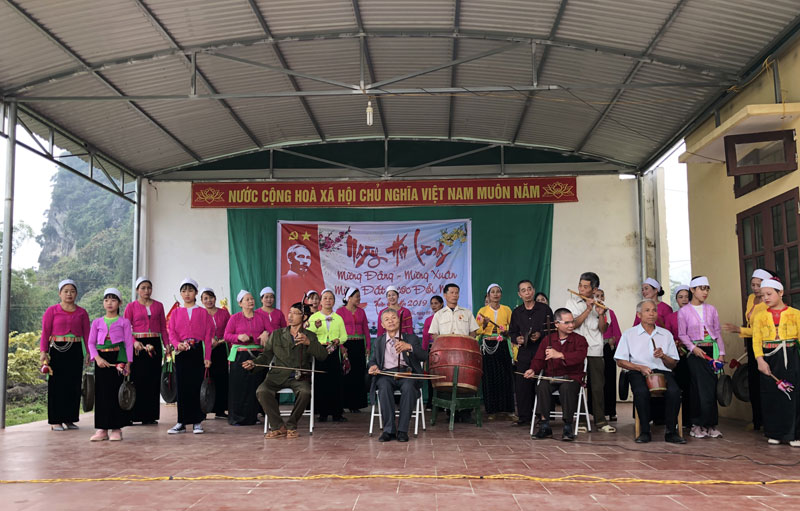
(HBO) - I came back to Luc Doi hamlet, Kim Binh commune on the first day of the Lunar New Year. I arrived at Mrs. Bui Thi Ky's house, the chairman of the club to preserving the identity of Muong ethnic culture.

The performance of the club in the village
festival
It is known that the Club was established in
May 2014. At the beginning, the Club had only 23 members. Up till now the
number of the members has been thirty ones of different ages and industries,
including children and teenagers.
Saying about the operation of the club, Ms.
Ky has told me that in order to get today’s results, we have experienced many
difficulties. The biggest difficulty is that the initial cost of the club is
limited. There were times when we had to mobilize the contributions of the mass
organizations in the locality and the members of the club. The instrument and costumes
were mostly self-made.
Besides, the language barrier between members
was also a great difficulty because some of them were Kinh ethnic people, so
learning about Muong culture is not easy. The most difficult is the young
people's indifference to the folklore of the nation, causing many obstacles for
us to transmit to the children. However, it is very fortunate for us to receive
a lot of interest and support from mass organizations from provincial to
commune levels, the support of the community and the consensus of the club’s
members, which has created further motivation for us to keep trying”.
Ms. Bui Dieu Linh, (14 years old) the club
member says "When I was little, my grandmother often told me the stories of
Muong people such as The Land Laying Epic, Mr. Cuoi and lullaby. Yet, I still
did not very well understand them. Since participating in the club, we have
heard and learned the ancient stories, lullabies, folks, Thuong Rang and Bo
Meng. I feel really proud because I was born and grew up on a land with a
strong cultural identity.
Spanning thousands of hectares and winding gracefully along mountain slopes, hillsides, and riverbanks, the terraced rice fields of Lac Son District present a stunning and captivating beauty. This region, renowned for its remarkable terraced landscapes, is also the centre of Hoa Binh Culture known for numerous archaeological sites.
The life of Mong people in Hang Kia and Pa Co communes of Mai Chau district has improved much thanks to tourism development.
The man-made Hoa Binh Lake, with a water surface area of approximately 9,000 hectares and a capacity of 9.45 billion cubic meters, stretches over 200 kilometers from Hoa Binh to Son La provinces. With the goal of developing into a national tourism area, the Hoa Binh Lake tourism area is expected to not only become the largest tourism centre in the province but also one of the 12 key tourist destinations in the northern midland and mountainous region of Vietnam.
Da Bia hamlet, now Duc Phong, in Tien Phong commune, Da Bac district, was once almost isolated from the outside as the only way to the hamlet was to get a boat ride across the Hoa Binh reservoir. However, as its tourism potential has been unleashed, the hamlet has established itself as one of the most attractive destinations on the tourism map. It has even received the ASEAN Community-Based Tourism Awards in 2019.
In the first 9 months of 2024, Mai Chau district, Hoa Binh province welcomed over 684 thousand visitors to visit and relax. In which, over 516 thousand domestic visitors and more than 168 thousand international visitors. Total revenue from tourism is estimated at over 821 billion VND.
Da Bac district, bestowed with stunning landscapes, is developing ecological and resort tourism offerings. Several tourist sites, put into operation this year, has attracted throngs of high-spending and young domestic visitors.



